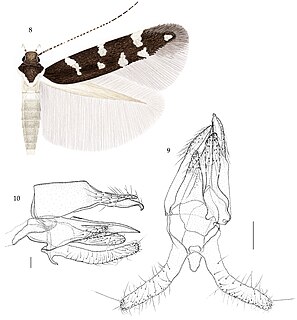Nebrarctia is a genus of moths in the family Erebidae from the Near East, Central Asia and Himalayas. The genus was erected by Otto Staudinger in 1891.
Epichilo is a genus of moths of the family Crambidae.
Autophila is a genus of moths in the family Erebidae.
Zekelita is a genus of moths of the family Erebidae. The genus was erected by Francis Walker in 1863.

In telecommunications, 5G is the fifth generation technology standard for broadband cellular networks, which cellular phone companies began deploying worldwide in 2019, and is the planned successor to the 4G networks which provide connectivity to most current cellphones. 5G networks are predicted to have more than 1.7 billion subscribers worldwide by 2025, according to the GSM Association. Like its predecessors, 5G networks are cellular networks, in which the service area is divided into small geographical areas called cells. All 5G wireless devices in a cell are connected to the Internet and telephone network by radio waves through a local antenna in the cell. The main advantage of the new networks is that they will have greater bandwidth, giving higher download speeds, eventually up to 10 gigabits per second (Gbit/s). Due to the increased bandwidth, it is expected the networks will not exclusively serve cellphones like existing cellular networks, but also be used as general internet service providers for laptops and desktop computers, competing with existing ISPs such as cable internet, and also will make possible new applications in internet of things (IoT) and machine to machine areas. 4G cellphones are not able to use the new networks, which require 5G enabled wireless devices.

Vulcaniella is a genus of moths in the family Cosmopterigidae, containing the following species:

Jordanita is a genus of moths of the family Zygaenidae.
Jordanita vartianae is a moth of the family Zygaenidae. It is endemic to southern and central Spain.
Aprophthasia is a monotypic snout moth genus described by Hans Georg Amsel in 1968. It contains the species Aprophthasia vartianae, described by the same author. It is found in Pakistan.

Nebrarctia transversa is a moth of the family Erebidae. It is found in India, Pakistan, Afghanistan and Tajikistan.
Epermenia vartianae is a moth of the family Epermeniidae. It is found in south-eastern Afghanistan and Tajikistan.
Dervishiya is a genus of moths in the family Cossidae.
Phragmacossia is a genus of moths in the family Cossidae.
Dervishiya vartianae is a moth in the family Cossidae. It is found in Afghanistan.
Phragmacossia vartianae is a species of moth of the family Cossidae. It is found in Afghanistan.
Epichilo vartianae is a moth in the family Crambidae. It was first described by Stanisław Błeszyński in 1965. It is found in Pakistan.
Nemapogon vartianae is a moth of the family Tineidae. It is found in Syria and Turkey.
Elachista vartianae is a moth in the family Elachistidae. It was described by Parenti in 1981. It is found in Syria.

Epermenia is a genus of moths in the family Epermeniidae. The genus was first described by Jacob Hübner in 1825.
Epermenia nepalica is a moth in the family Epermeniidae. It was described by Reinhard Gaedike in 1996. It is found in Nepal.



